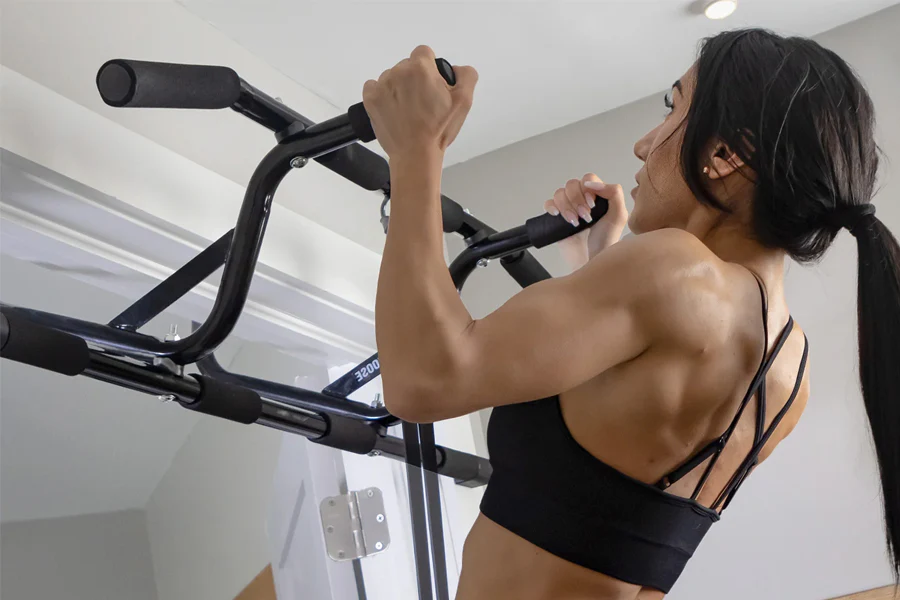What is a Pull Up Bar?
A pull up bar is a versatile and widely used piece of fitness equipment designed primarily for upper body strength training. It serves as an essential tool for performing pull-ups, chin-ups, and various bodyweight exercises that engage the muscles of the back, shoulders, and arms. This simple yet effective apparatus can be categorized into several types, each serving a different purpose and fitting diverse workout environments.
One of the most common forms is the doorway pull up bar, which is designed to be securely installed in a residential doorway. This option is ideal for individuals seeking an affordable and space-saving solution for their home workouts. Doorway bars can be easily mounted and removed, making them a convenient choice for many fitness enthusiasts.
In contrast, wall-mounted pull up bars provide a sturdier and more permanent solution, typically requiring installation into a wall structure. These bars are perfect for dedicated workout spaces and can support heavier weights, allowing for a more extensive range of exercises. Free-standing pull up bars are another alternative, offering the advantage of mobility and versatility. These units often come with additional features such as dip stations or parallel bars, enabling users to perform a variety of exercises with minimal setup.
The primary purpose of a pull up bar is to facilitate bodyweight training, a method highly regarded for its effectiveness in building muscle strength and improving overall fitness. Incorporating pull ups into a workout routine enhances upper body strength, engages core muscles, and improves grip strength. Additionally, the compact nature of pull up bars makes them an excellent choice for those who prefer exercising at home, ensuring users have access to effective workout options without the need for extensive gym equipment.
Benefits of Using a Pull Up Bar
The pull up bar is an essential piece of equipment for anyone aiming to enhance their strength, endurance, and overall fitness level. One of the primary physical benefits of using a pull up bar is muscle building. Engaging in pull ups activates multiple muscle groups, including the latissimus dorsi, biceps, and shoulders, resulting in improved muscle definition and mass. As a compound exercise, pull ups require coordination and engagement from different parts of the body, thereby maximizing muscle activation.
Another significant advantage of incorporating pull ups into one’s workout regimen is the improvement of grip strength. A stronger grip contributes to better performance in various exercises and daily activities, making pull ups a functional addition to fitness routines. Furthermore, performing pull ups effectively engages the core muscles, which enhances core stability. A well-developed core is crucial for maintaining proper posture, supporting spinal health, and preventing injuries.
Moreover, the benefits of using a pull up bar extend beyond the physical realm. Successfully executing pull ups can lead to enhanced mental fortitude and an increase in self-confidence. As individuals master this challenging exercise, they often experience a sense of accomplishment that can translate into improved motivation and resilience in other areas of their lives. Consequently, the pull up bar not only enhances physical fitness but also fosters mental strength and personal growth.
How to Use a Pull Up Bar: Techniques and Tips
Using a pull up bar can significantly enhance your upper body strength when executed with proper techniques. To begin, ensure that you select a sturdy pull up bar installed at a comfortable height to allow full range of motion without obstruction. Depending on your current fitness level, there are different grips you can utilize to perform pull-ups effectively.
The most common grip variations include the overhand grip, where your palms face away from you, and the underhand grip, also known as the chin-up grip, with palms facing towards you. Beginners may find the underhand grip easier as it encourages more engagement of the biceps. Whichever grip you choose, establish a firm hold on the bar with hands shoulder-width apart and arms fully extended.
Once your grip is secure, the next step is positioning your body correctly. Engage your core to stabilize your torso. As you pull your body upwards, aim to bring your chin above the bar while keeping your legs either straight or slightly bent at the knees to reduce swinging. Exhaling as you pull up and inhaling on the way down can aid in maintaining rhythm.

For beginners who may struggle with completing a full pull-up, start with assisted variations. Resistance bands can provide support as you learn the movement, gradually allowing you to transition to unassisted pull-ups. Alternatively, negative pull-ups, where you slowly lower yourself from the top position, can help build strength.
It is also beneficial to incorporate exercises that strengthen the back, shoulders, and arms, such as lat pulldowns and rows, to enhance your pull-up capabilities. Lastly, if you encounter challenges, focus on consistent practice and remember that progression takes time. By following these techniques and tips, you will develop the necessary strength and skills to effectively use a pull up bar and achieve your fitness goals.
Incorporating Pull Up Bar Exercises into Your Fitness Routine
Integrating pull up bar exercises into your fitness regimen can significantly enhance your strength training efforts. To effectively incorporate these movements, consider the structure of your weekly workouts. For optimal results, aim to include pull-up bar exercises at least two to three times per week. This frequency allows for adequate recovery while promoting muscle growth and endurance.
A well-balanced workout plan should ideally combine pull-ups with other strength training exercises and cardio. One popular approach is a push-pull workout split, where one day focuses on pushing movements such as bench presses and shoulder presses, while the next emphasizes pulling movements, including various pull-up bar exercises and rows. This method ensures that opposing muscle groups are engaged while providing rest for the others, creating a harmonious balance.
For those new to pull-ups, it may be beneficial to use assisted variations or negative pull-ups to build strength gradually. Progressing from these modified versions to traditional pull-ups can motivate you and prevent plateauing. Consider incorporating superset techniques, pairing pull-ups with push-ups or dumbbell exercises to enhance your overall performance and keep the routine dynamic.
Moreover, adding cardio elements can assist in conditioning while also promoting fat loss. Consider circuit training, where you alternate between pull-up bar exercises and high-intensity cardio intervals, such as jumping jacks or sprints. This combination not only builds strength but also boosts cardiovascular endurance, making your workout more efficient.
In conclusion, combining pull up bar exercises with a wider array of strength training and cardio options can significantly elevate your fitness routine. Tailor your approach to your specific fitness goals and maintain variety to sustain motivation and consistent progress.
May Be You Also Read
